Development and validation of the Automated Vehicle Acceptance Questionnaire for Pedestrians (AVAQ-P)
IF 3.5
2区 工程技术
Q1 PSYCHOLOGY, APPLIED
Transportation Research Part F-Traffic Psychology and Behaviour
Pub Date : 2025-05-14
DOI:10.1016/j.trf.2025.04.016
引用次数: 0
Abstract
The investigation of automated vehicle acceptance (AVA) has received considerable attention in the past few years. Understanding the factors impacting their acceptance is pivotal to ensure a large-scale and wide acceptance of AVs. The AVA by pedestrians is still little understood. To address this knowledge gap, the main objective of this study is to develop and validate an instrument for the assessment of AVA by pedestrians. We tested this instrument on a German sample of pedestrians (n = 136), considering their individual demographic characteristics, and level of affinity for technology interaction. A four-step approach was adopted to analyze the data. First, a principal component analysis was performed to reduce the number of items, exploring the sources of variation in the dataset. Second, the principal components were subjected to a confirmatory factor analysis to investigate the validity and reliability of the proposed measurement model. Third, structural equation modeling was conducted to estimate the path relationships between our constructs. The study has revealed differences between the effect sizes and significance levels of the factors influencing pedestrians’ AVA. The AVA by pedestrians was most strongly influenced by affinity for technology interaction (i.e., extent to which the individual actively approaches or avoids the interaction with new systems), performance expectancy (i.e., extent to which the individual believes that using the system will support them in achieving gains in the performance of the task) and social influence (i.e., extent to which the individual believes that people important to them think that the individual should perform the behavior). Male pedestrians were more likely to accept AVs. We also revealed significant interaction effects of age on the variables in our model. With this work, we have contributed to the development and validation of the Automated Vehicle Acceptance Questionnaire for Pedestrians (AVAQ-P). We recommend future research to replicate the study with a larger, more representative and gender-diverse population of pedestrians, considering cross-cultural differences in AVA.
行人自动驾驶车辆接受度问卷(AVAQ-P)的编制与验证
在过去的几年中,对自动车辆验收(AVA)的研究受到了相当大的关注。了解影响自动驾驶汽车接受度的因素对于确保自动驾驶汽车的大规模和广泛接受至关重要。行人对AVA的了解仍然很少。为了解决这一知识差距,本研究的主要目标是开发和验证行人AVA评估工具。我们在德国的行人样本(n = 136)上测试了这个工具,考虑了他们的个人人口统计学特征和对技术互动的亲和力水平。采用四步法对数据进行分析。首先,进行主成分分析以减少项目数量,探索数据集中变化的来源。其次,对主成分进行验证性因子分析,以考察所提出的测量模型的效度和信度。第三,采用结构方程模型来估计结构之间的路径关系。研究揭示了影响行人AVA的因素在效应量和显著性水平上的差异。行人的AVA受技术交互亲和力(即个人积极接近或避免与新系统交互的程度)、性能预期(即个人认为使用该系统将支持他们在任务执行中获得收益的程度)和社会影响(即:个人认为对自己重要的人认为自己应该采取某种行为的程度)。男性行人更容易接受自动驾驶汽车。我们还揭示了年龄对模型中变量的显著交互作用。通过这项工作,我们为行人自动车辆接受问卷(AVAQ-P)的开发和验证做出了贡献。我们建议未来的研究在考虑AVA的跨文化差异的情况下,在更大、更有代表性和性别多样化的行人人群中重复这项研究。
本文章由计算机程序翻译,如有差异,请以英文原文为准。
求助全文
约1分钟内获得全文
求助全文
来源期刊
CiteScore
7.60
自引率
14.60%
发文量
239
审稿时长
71 days
期刊介绍:
Transportation Research Part F: Traffic Psychology and Behaviour focuses on the behavioural and psychological aspects of traffic and transport. The aim of the journal is to enhance theory development, improve the quality of empirical studies and to stimulate the application of research findings in practice. TRF provides a focus and a means of communication for the considerable amount of research activities that are now being carried out in this field. The journal provides a forum for transportation researchers, psychologists, ergonomists, engineers and policy-makers with an interest in traffic and transport psychology.

 求助内容:
求助内容: 应助结果提醒方式:
应助结果提醒方式:


